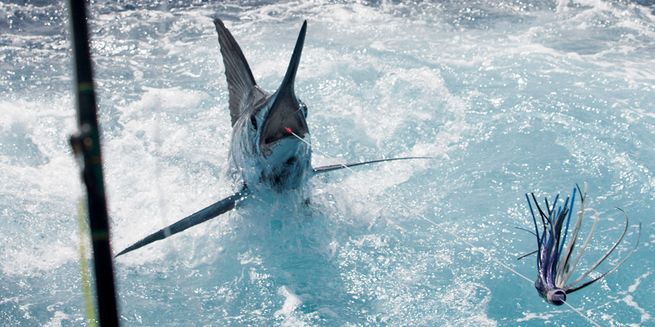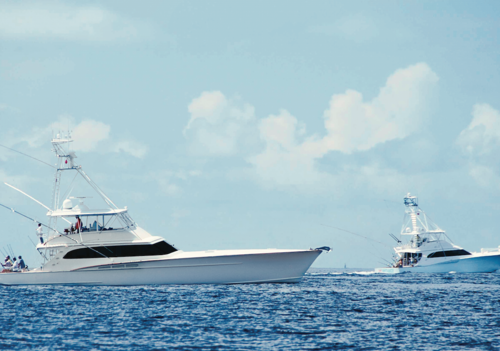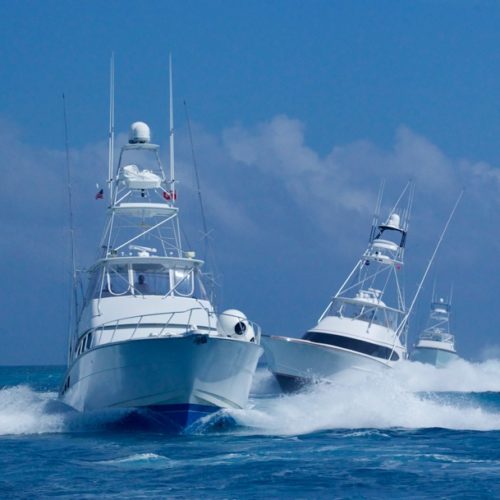
What's In Your Spread?
What tackle to use for big blue marlin and little whites that frequent Bermuda’s waters during the tournament season.

In a place filled with unparalleled beauty and peace, we sometimes witness incredible acts of violence — and we never seem to get enough. Watching a blue marlin repeatedly attack a lure, bait or teaser ranks up there with one the biggest thrills on the planet, and the guys who like to see it will travel great distances and spend enormous amounts of treasure to experience that thrill again and again.
The purple and blue waters offshore Bermuda attract and hold some truly large blue marlin, and when they come up in the spread, they usually mean business. Blue marlin rarely follow a lure or teaser for long before trying to eat it; the strike is quick, violent and vicious. These “blind strikes” on lures or teasers take your breath away, and if you happen to be looking at the lure in peril when the fish strikes, you’ll be blessed with the indelible memory of a blue marlin attack — an image that some anglers are cursed to pursue until they can’t stand on the boat any longer.
Forget about fighting them, watching a blue marlin eat is the biggest thrill in blue water. But to get a marlin in the spread and eat, you have to be in the right spot with the right lures or baits. While I personally believe that 90 percent of fishing success comes with being in the right spot, I’m in the decided minority if I’m sitting at a table full of lure makers. We all have our preferences when it comes to what we pull, and if your captains and mates lose confidence in a lure or bait, that lure goes in the drawer or that bait gets jerked from the spread, and it’s replaced with something that they feel might work better. A lot of it is still guesswork, which adds to the challenge.
The following five captains and their crews guess right more often than not, so we decided to pick their collective brains to see how they go about tackling the mixture of big blue marlin and little whites that frequent Bermuda’s waters during the summer tournament season.
Mattanza
Capt. Brooks Rans runs his charter boat Mattanza, a 51-foot Heritage, with the passion for fishing found among most native Bermudians. His team won the Billfish Blast in 2012 and several dailies in other events, including a release daily where his team scored the second grand slam in Bermudan history with two blues, one white and one spearfish. He knows these waters and how to catch what is in them. Rans starts off by pulling his lures a bit faster than a lot of boats he fishes against. “I usually troll at 9 knots — a little faster — so I can cover more ground. The extra ground you cover might get an extra bite or two,” he says. Rans says that he likes to fish lures that are popular in the area. “I fish the standard ones: super plungers, Leopards and Andy Moyes’ lures. I fish a lot of Moyes’ lures, since they are keel-weighted and keep the hook facing up, which I think gives you a better hookup percentage,” he says. “Anything Andy makes is good, and his Leopard is awesome.”
According to Rans, the Leopard lure from Big T Lures made its way to Bermuda when Alan Card and Alan DeSilva met up with the “T” of Big T Lures (bigtlures.co.za) to get some skirts and ended up coming back with a bunch of lures as well. They handed them out to some of the captains in the area who started to catch a bunch of big fish on them. “The Leopard looks kind of like a Mold Craft Bobby Brown with a back taper on it, although it’s longer and thinner than a Bobby Brown — like a Wide Range with an angled face,” Rans says.
When it comes to colors, Rans says that he’s “not too fussy about them. Most of the locals here fish dark colors; we like blacks, purples and blues. Sometimes we pull black and yellow to mimic the yellowfins, but I normally don’t worry much about the colors.”Rans’ typical spread consists of two big lure teasers from the fly-bridge, a dredge and bowling-pin chain from the cockpit, and five lures. “Our dredge is armed with mini mudflaps, plastic shads or a combo of shads and flaps, or even Squid Nation squids. We run four lures out the outriggers and one shotgun down the middle. We also use tag lines on all the rigger baits because they give you a better drop back on the strike.”
Paradise One
With its sibling owner/operators, Delvin and Capt. Allan Bean, Paradise One packs a lot of local knowledge into one 54-foot sport-fishing catamaran. Not limiting their fishing to chasing big blue marlin in the summertime, the Beans spend a lot of time commercial fishing as well, so their boat is on the water almost every day. Delvin, who works as the mate on most trips, also hires out to fish wahoo tournaments in the Bahamas — one of his many specialties. While he tends to use ballyhoo and sea witches when chasing wahoo, his spread makes a change come blue marlin season.
“We go to all artificial lures — all plastic. I get lures in from six different companies, and I bring a lot in for other boats as well. I like everything, really. You name it, I will run it: big South African lures from Big T, Leopard lures and Boombas. Everybody loves super plungers, Wide Ranges, Super Chuggers — a lot of what you pull depends on the conditions. If the lure can still do what it’s supposed to do, then I’ll run it.” Delvin says that he has more than 500 lures rigged and ready to go on his boats.
As far as color goes, Delvin pulls as many variations as he has lures. “There’s no one color. You just have to figure out what they are biting. Blues, blacks, purples, reds — with six different lures, I’ll pull six different colors. Then I sit back and watch what the fish do and see which ones they come up on the most,” he says. Delvin likes to pull his lures at 8 to 8½ knots and uses 300- to 650-pound mono leaders. “We only pull 130s during the summer because you don’t want to bring a knife to a gun fight. There’s some big fish out there.” Delvin doesn’t pull teasers, just six armed lures. “We are a charter boat, so my guys usually don’t have a clue about pitching. If a fish comes up on a lure in my spread, I want it to have a hook in it,” Delvin says. “I can’t help these guys out with the hookup during a tournament.”
Plane Simple
Like a lot of blue marlin fishermen these days, Capt. Jimmy Werling on the 70-foot Spencer Plane Simple likes to run a mixture of dead baits and lures in hope of upping the hookup percentage on smaller blues and white marlin, which can now quickly add to your tournament totals in terms of release points.Andy Moyes hard at work in his lure shed. “I like to run circle-hooked ballyhoo on my flat lines. During the first part of the season, we even pull ballyhoo on our long riggers since there are more white marlin around. We pull them on 30s and 50s with 80- and 100-pound fluorocarbon leaders. Once we stop catching a lot of whites, we put lures out on the longs, but they are small lures like a 1-inch-diameter Yap,” Werling says.
Werling pulls his large lures from the short-rigger position. “I usually pull a Top Gun concave head on the right short in purple and black or black and red. On the left short rigger, I pull a Joe Yee Super Plunger in purple and blue or purple and black,” he says.When it comes to teasers, Werling is a big believer in matching his teaser colors to the dredges below and the daisy chains on the surface. “We pull a mullet dredge on one side and mud flaps on the other,” Werling says. “In front of the mudflaps, we usually attach blue and black Ilanders. On the mullet, we use Ilanders in pink and white called the Supreme. I pull the green squid daisy chains from the flybridge and have a mackerel and an Iland Express the same color as the dredge on the side that it’s on. If a fish comes up on the Supreme dredge, I want it to see the same color behind the chain.”When it comes time to make a pitch, Werling like to use 50s and 80s, depending on the size of the fish, and always tosses out a mackerel.
Fa La Me
Capt. Rob Moore and the crew on Fa La Me enjoy a level of success that is hard to fathom in Atlantic blue marlin tournaments. The only team to win the Bermuda Triple Crown twice — 2012 and 2014 — and winners of the prestigious Bahamas Billfish Championship in 2012, you’d be wise to listen to anything these fellas have to say about marlin fishing. A professional captain for more than 27 years, Moore spends 8 to 10 months a year fishing tournaments throughout the Caribbean. Moore is one of those lucky captains whose owners (Frank and Mary Ellen Rodriguez) are avid anglers who like to keep their boat fishing.
He doesn’t sit at the dock if the weather cooperates. I had a hard time getting in touch with Moore because he fished every day in the Dominican Republic while I put this story together, but I did get a short Facebook message that cuts to the chase and gives you idea of what his team prefers when it comes to lure selection:
“As far as our spread goes, we like to have a Softhead Super Chugger out there, as well as Wide Ranges. The Leopard is a great lure in Bermuda and, of course, Bart Miller’s 1656. And I like anything that Andy Moyes makes. You need to use big leaders and big hooks, ’cause big mama lives in Bermuda.”
Wound Up, Weez in the Keys
As a professional lure maker, freelance captain and mate, Capt. Andy Moyes probably brings more experience and perspective to pulling lures than most. He’s chased the biggest fish all over the world and has caught more than his fair share of giant marlin and tournament-winning fish. His lures, as you read in some of the statements above, are fast becoming fixtures in the spreads of some of the best blue marlin captains the world over.As far as Bermuda goes, Moyes says that his best lure is his medium plunger in black and green.
“That lure has had some really good success there. It caught the 918 on Wound Up and a 598 on Weez in the Keys. There’s just something about that lure. It has the right hum or something. Just put it out on the right long. We released a bunch off it as well. We caught seven in a row one time — first bite.“ I’ve always liked pulling medium to small-medium on the longs with a large Gay Boy on the short. I usually put one of my Dark-N-Stormys on the other short. That lure got its name from Bermuda. It’s kind of like the Leopard,” he says.
Moyes is part of the growing number of lure fishermen who have started moving toward using smaller hooks. “I like a single 10/0 Koga hook from Quick Rig. I feel that the smaller hooks give you a better hookup percentage, and I don’t mind using a smaller hook if it’s still strong. I don’t think that there’s a perfect hook out there right now, although the Koga is pretty close and so is Bart’s Pa’a hook.” Moyes pulls the full teaser arsenal with an all-black Sumo on one bridge teaser and an Argus purple and gold on the other side.
“We fish mudflaps on our dredges there, but I only pull fully armed lures. I might pull five if there are a lot of whites around, but I’ve had bad luck with five out when a big fish jumps over that fifth line and cuts off,” he says.So there you have it — straight from the horses’ mouths. What are you going to pull this year?

